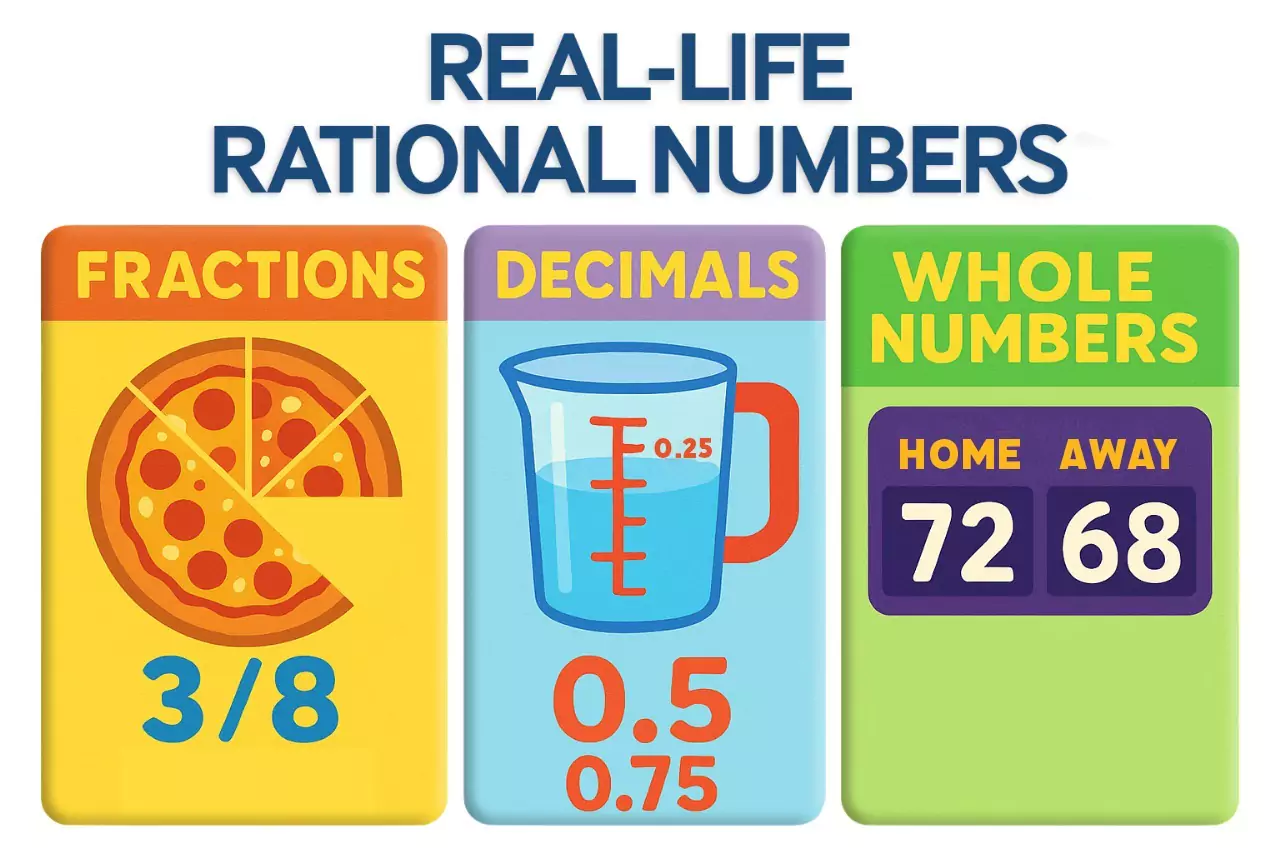How Kids Can Master Rational Numbers

Let’s Dig Deeper: What Are Rational Numbers?
Rational numbers are any numbers that can be written as a fraction, p/q, where p and q are integers, and q is a non-zero denominator. So, they include:
- Whole numbers (e.g., 4, which can also be written as 4/1)
- Fractions (e.g., ¾)
- Terminating decimals (e.g., 0.75, which can also be written as ¾ )
- Repeating decimals (e.g. 0.333…, which can also be written as ⅓ )
Zero also counts, since it can be written as 0/1. What sets rational numbers apart is that they always have a clear fractional form.
By contrast, some numbers don’t fit this definition. They are called irrational numbers, and they can’t be written neatly as a fraction. Their decimals go on forever without repeating a pattern, which makes them impossible to pin down exactly.
For example, √2 starts as 1.414… and never stops, while π (pi) begins with 3.14159… and continues endlessly.
When teaching rational numbers for kids, highlight how they’re easier to work with: rational numbers have tidy fractional forms. You can also point out fractions in recipes or whole numbers in scores. The more kids recognize rational numbers around them, the less intimidating the concept becomes.

Why Mastering Rational Numbers Matters
Rational numbers act like a bridge in math. They connect the whole-number world kids already know to more advanced ideas like ratios, proportions, and algebra. Without this bridge, later topics can feel difficult to understand.
Beyond the classroom, rational numbers help kids make sense of their everyday world, from tracking time on a stopwatch to counting down to their birthday. Building confidence with rational numbers strengthens number sense and sets the stage for success in future math learning.
Common Challenges Kids Face
Kids often find rational numbers challenging because they show up in different forms. Knowing the common struggles helps you offer the right support.
- Confusing Fractions With Decimals: Many children see fractions and decimals as two separate topics. Without realizing that ½ and 0.5 are the same, they may get stuck when switching between them.
- Difficulty With Negative Rational Numbers: Placing -3/4 on a number line or imagining “less than zero” often doesn’t click immediately. Kids need repeated, visual practice to make sense of it.
- Struggling To Compare and Order Rational Numbers: Which is larger: 0.6 or 2/3? Without a clear strategy, kids often resort to guessing.
- Forgetting How To Convert Between Forms: Kids often learn fractions, decimals, and percentages in isolation. Without practice, remembering how to convert between these forms can be challenging.
Strategies To Help Kids Master Rational Numbers
Learning rational numbers for kids doesn’t have to be overwhelming. With the following strategies, you can make practice enjoyable:
- Start With Visuals: Children often need to see a number before they can truly understand it. A shaded circle showing ¾ or a point placed at –⅖ on a number line can make the abstract concrete.
- Practice Conversions: One of the biggest hurdles for kids is realizing that fractions, decimals, and percentages can be used as three different ways of showing the same number. Practice is the key. Show them that 50% off is the same as ½, or that 0.2 equals 20%.
- Relatable Scenarios: Math feels easier when kids see it in action. Splitting snacks with friends, dividing points in a video game, or finding your odds of winning a die roll all bring rational numbers to life.
- Comparison Games: Turn ordering numbers into a playful challenge. Use flash cards or games to rank rational numbers from smallest to largest. The game-like element keeps practice engaging.
How Prodigy Makes Learning Rational Numbers Fun
Rational numbers show up everywhere, and that’s exactly why helping your child master them matters. Each time they measure time on a stopwatch, compare scores in a game, or solve a fraction in class, they’re practicing skills that build confidence and prepare them for bigger math challenges.
Mastering rational numbers takes practice, but worksheets alone don’t always capture a child’s attention. Prodigy Math transforms that practice into an adventure. Inside the game, kids face adaptive math questions, some of which involve fractions, decimals, and integers. Every challenge is tailored to their skill level, so they get achievable and engaging questions. When a problem gets tricky, built-in hints and step-by-step explanations guide them without taking away the joy of discovery.
Why not make practice feel like play? With Prodigy Math, your child can explore rational numbers through quests and battles while learning at their own pace.











